The old MLP model rarely saw stock buybacks. Traditionally the General Partner (GP) would sell assets to the MLP it controlled in a non-arms-length transaction. The MLP would issue equity and debt to pay for them. MLPs were sellers of their own units, not buyers.
Today’s midstream energy infrastructure sector has left that model behind. Most companies are corporations and most have buyback programs in place. Of the names listed, 12 of 16 retired some stock last year and 14 are expected to do so this year.
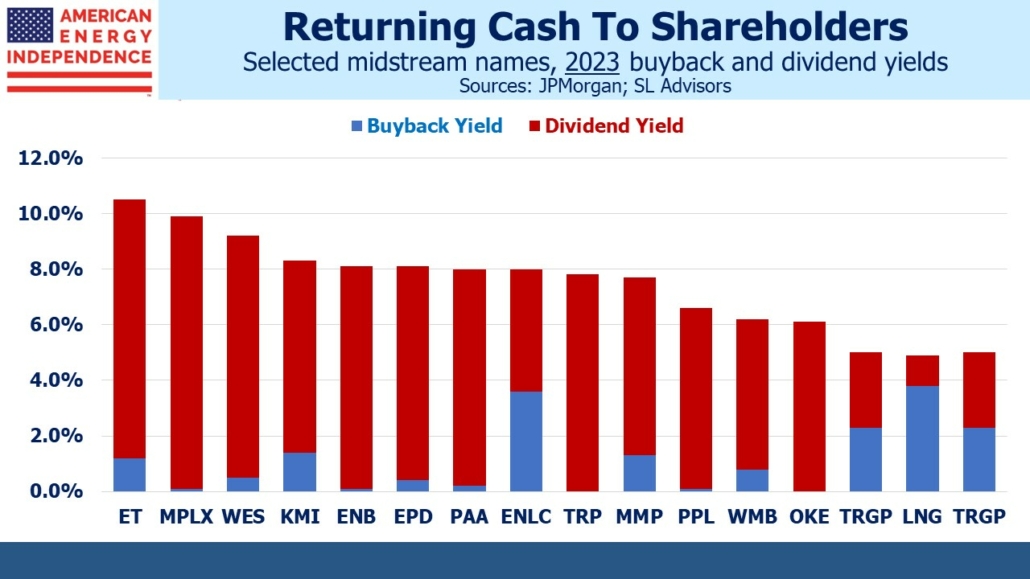
The buyback yield (ie portion of outstanding shares repurchased) can be added to the dividend yield to give the total return to shareholders exclusive of price changes. By this measure, half the sixteen companies listed offer a return of 7.9% or greater, assuming they execute their buyback programs as JPMorgan projects through the remainder of the year.
This year’s median dividend yield + buyback yield of 7.9% is up from 7.4% last year, a 7% growth rate. Returns are increasing.
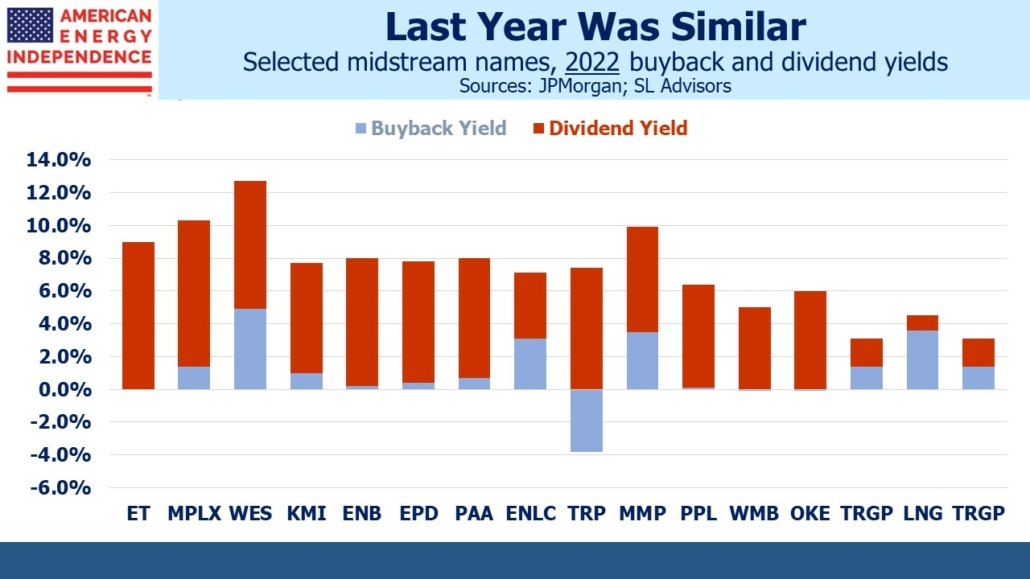
MLPs are repurchasing shares alongside their c-corp peers. Without a controlling GP poised to drop down assets they have more conventional growth capex opportunities of acquisitions and re-investing back in the business.
M&A activity has picked up recently, with Oneok’s (OKE) acquisition of Magellan Midstream (MMP) and Energy Transfer’s (ET) purchase of Crestwood. Investors worried that ET’s issuance of $2.7BN in equity to fund this purchase indicated that buybacks were a lower priority. But the company assuaged these fears with a presentation that earmarks up to 20% of distributable cash flow to buybacks once they’ve reduced their Debt:EBITDA ratio close to 4.0X.
The OKE/MMP deal looks likely to receive shareholder approval now that independent proxy firms Glass Lewis and ISS both recommended a yes vote.
The dealmaking reflects increased confidence in the sector’s outlook by management.
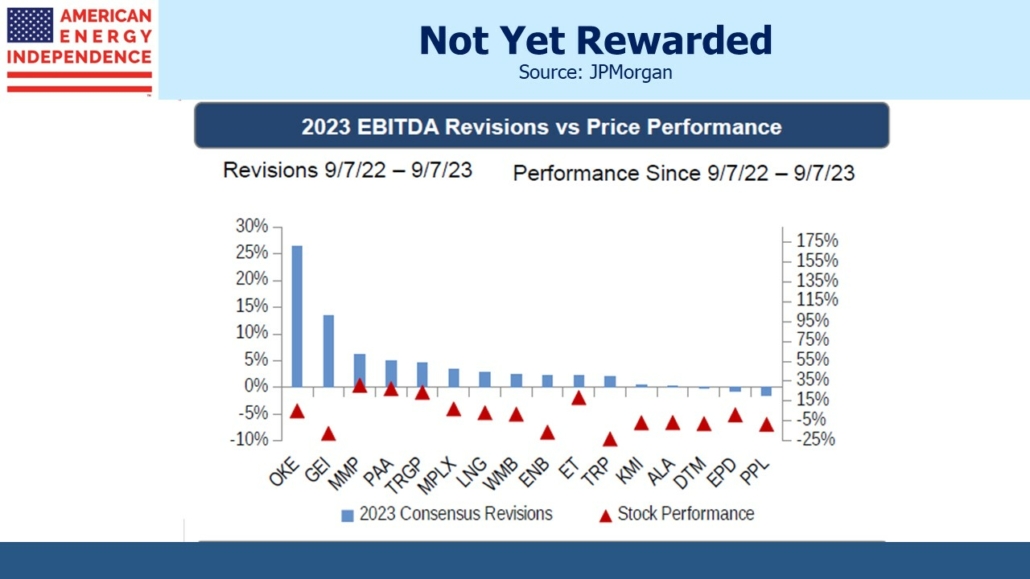
Many companies have revised up their 2023 EBITDA over the past year without seeing it reflected in stock price performance.
Valuations are still below where they were in 2019 before the pandemic, even though companies have de-risked by reducing leverage. Enterprise Value/EBITDA averaged 11.5X for the sector according to JPMorgan and is below 10.0X today. Leverage is coming down and dividends are growing. Capex remains well below the levels of 2018, partly because environmental extremists have turned the courts into a weapon against all kinds of infrastructure including renewables (see Windpower Faces A Tempest). This has helped improve free cash flow among pipeline companies.
Canada has similar problems. The TransMountain expansion from Alberta to British Columbia has quadrupled in cost since Kinder Morgan deftly sold it to the Canadian government in 2018. The ultimate tab might go even higher. Engineering difficulties have led the company to request a different route, but the indigenous community is opposed. Public hearings are scheduled, and the crude pipeline’s completion could be pushed back a further nine months to the end of next year. Unlike in the US, Canada’s native tribes never signed peace treaties with the European settlers. As a result they have greater legal rights including limited sovereignty over their land. Canadian construction projects often have to work around this, as TransMountain is having to.
Unexpected delays are common in pipeline projects, which is why it’s unattractive to build them. This makes the existing stock of infrastructure more valuable.
I used to think climate extremists were trying to put us out of business, but I have since developed a more subtle appreciation of their positive impact on free cash flow since there’s less spending on new pipeline construction.
Hug a climate protester and drive him to his next protest.
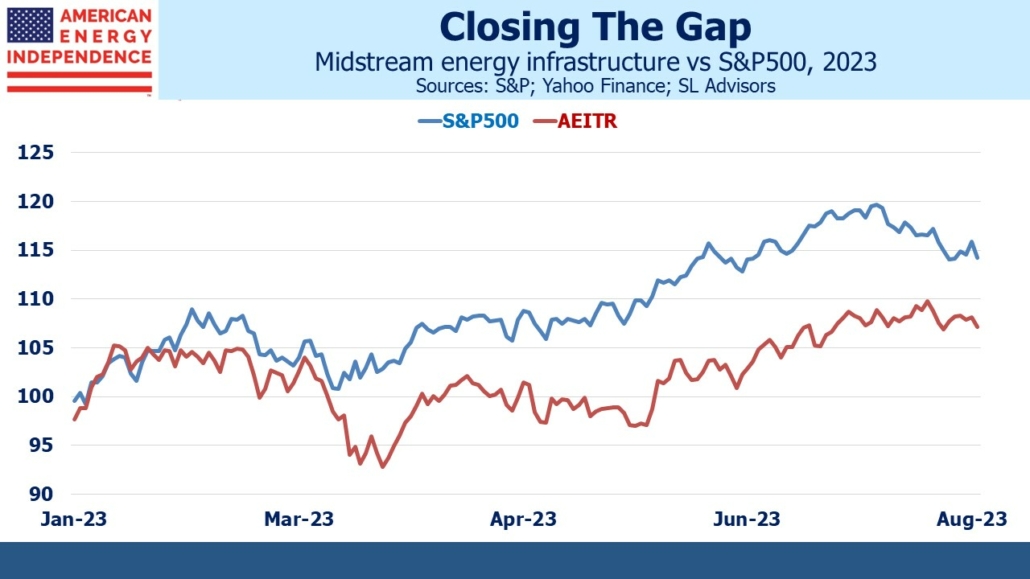
In spite of all these positives, after two very strong years the pipeline sector as represented by the American Energy Independence Index is lagging the broader market this year. It looks cheap to us.
US natural gas prices have been weak in recent months. Domestic demand isn’t growing fast enough to match production – the market needs more liquefaction capacity.
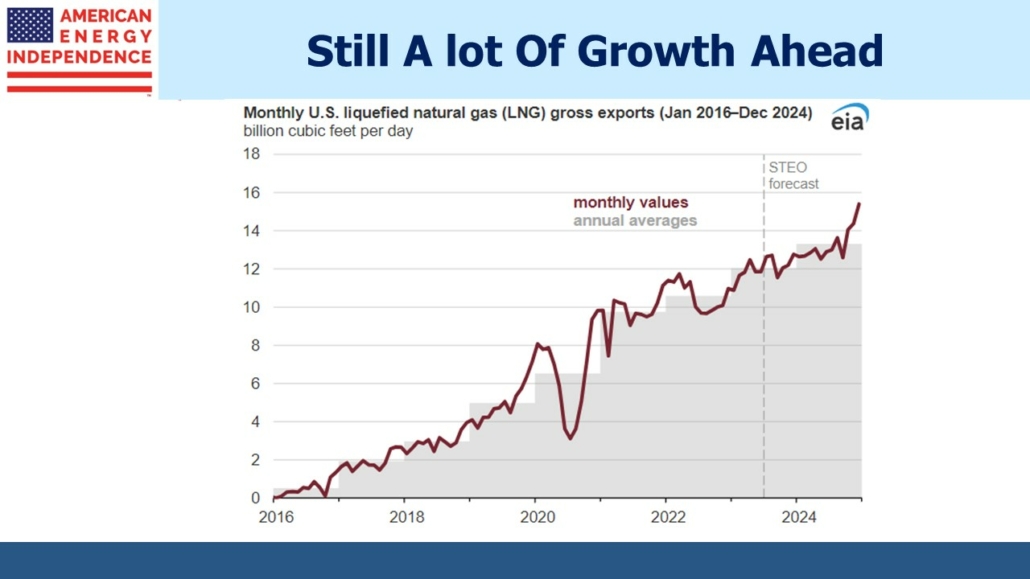
Fortunately, that’s coming. The US Energy Information Administration (EIA) expects gross LNG exports to reach 14 Billion Cubic Feet per Day (BCF/D) by the end of next year. The net may be smaller if Massachusetts imports LNG as they have in the past (see Why Staying Warm In Boston Will Cost You).
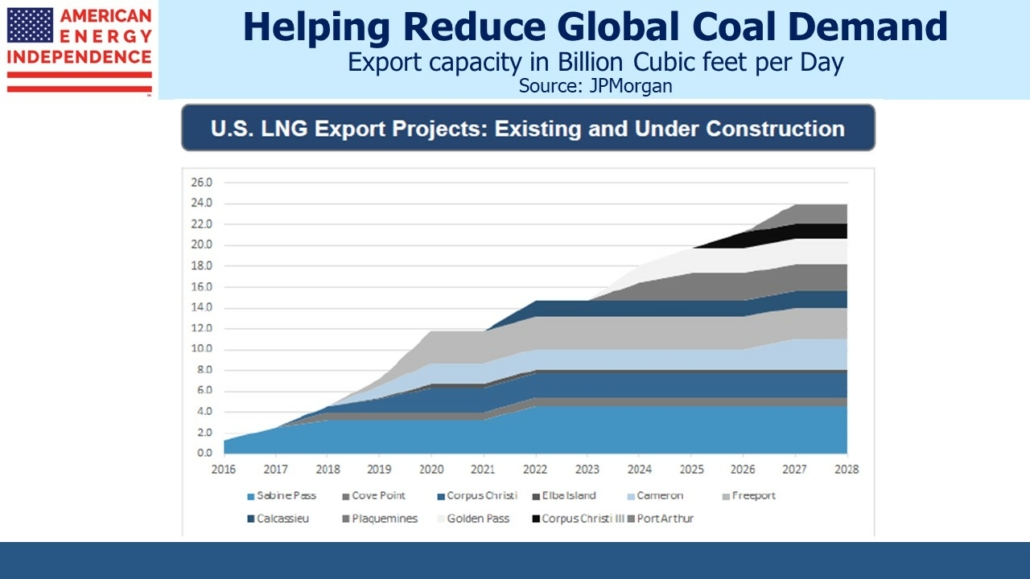
Based on projects under construction, we should be exporting 24 BCF/D by 2027, a doubling over five years. This will add upward pressure to cheap US prices and will enable other countries to reduce their use of coal for power generation.
The valuations, strong fundamentals and growth prospects make this one of the most overlooked sectors in the market.
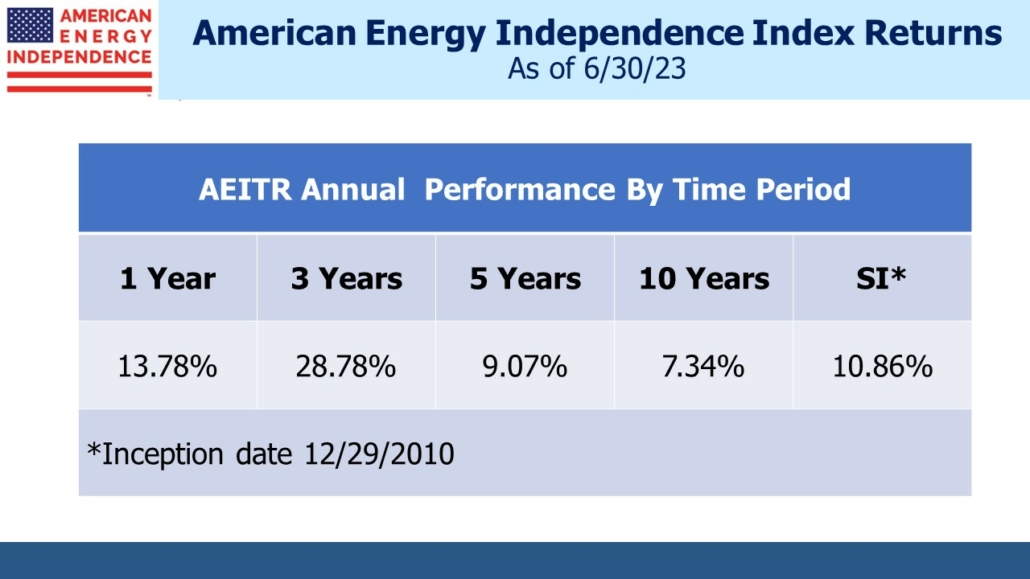
—
Originally Posted September 13, 2023 – Pipelines Returning More Cash
Important Disclosures
The information provided is for informational purposes only and investors should determine for themselves whether a particular service, security or product is suitable for their investment needs. The information contained herein is not complete, may not be current, is subject to change, and is subject to, and qualified in its entirety by, the more complete disclosures, risk factors and other terms that are contained in the disclosure, prospectus, and offering. Certain information herein has been obtained from third party sources and, although believed to be reliable, has not been independently verified and its accuracy or completeness cannot be guaranteed. No representation is made with respect to the accuracy, completeness or timeliness of this information. Nothing provided on this site constitutes tax advice. Individuals should seek the advice of their own tax advisor for specific information regarding tax consequences of investments. Investments in securities entail risk and are not suitable for all investors. This site is not a recommendation nor an offer to sell (or solicitation of an offer to buy) securities in the United States or in any other jurisdiction.
References to indexes and benchmarks are hypothetical illustrations of aggregate returns and do not reflect the performance of any actual investment. Investors cannot invest in an index and do not reflect the deduction of the advisor’s fees or other trading expenses. There can be no assurance that current investments will be profitable. Actual realized returns will depend on, among other factors, the value of assets and market conditions at the time of disposition, any related transaction costs, and the timing of the purchase. Indexes and benchmarks may not directly correlate or only partially relate to portfolios managed by SL Advisors as they have different underlying investments and may use different strategies or have different objectives than portfolios managed by SL Advisors (e.g. The Alerian index is a group MLP securities in the oil and gas industries. Portfolios may not include the same investments that are included in the Alerian Index. The S & P Index does not directly relate to investment strategies managed by SL Advisers.)
This site may contain forward-looking statements relating to the objectives, opportunities, and the future performance of the U.S. market generally. Forward-looking statements may be identified by the use of such words as; “believe,” “expect,” “anticipate,” “should,” “planned,” “estimated,” “potential” and other similar terms. Examples of forward-looking statements include, but are not limited to, estimates with respect to financial condition, results of operations, and success or lack of success of any particular investment strategy. All are subject to various factors, including, but not limited to general and local economic conditions, changing levels of competition within certain industries and markets, changes in interest rates, changes in legislation or regulation, and other economic, competitive, governmental, regulatory and technological factors affecting a portfolio’s operations that could cause actual results to differ materially from projected results. Such statements are forward-looking in nature and involves a number of known and unknown risks, uncertainties and other factors, and accordingly, actual results may differ materially from those reflected or contemplated in such forward-looking statements. Prospective investors are cautioned not to place undue reliance on any forward-looking statements or examples. None of SL Advisors LLC or any of its affiliates or principals nor any other individual or entity assumes any obligation to update any forward-looking statements as a result of new information, subsequent events or any other circumstances. All statements made herein speak only as of the date that they were made. r
Certain hyperlinks or referenced websites on the Site, if any, are for your convenience and forward you to third parties’ websites, which generally are recognized by their top level domain name. Any descriptions of, references to, or links to other products, publications or services does not constitute an endorsement, authorization, sponsorship by or affiliation with SL Advisors LLC with respect to any linked site or its sponsor, unless expressly stated by SL Advisors LLC. Any such information, products or sites have not necessarily been reviewed by SL Advisors LLC and are provided or maintained by third parties over whom SL Advisors LLC exercise no control. SL Advisors LLC expressly disclaim any responsibility for the content, the accuracy of the information, and/or quality of products or services provided by or advertised on these third-party sites.
All investment strategies have the potential for profit or loss. Different types of investments involve varying degrees of risk, and there can be no assurance that any specific investment will be suitable or profitable for a client’s investment portfolio.
Past performance of the American Energy Independence Index is not indicative of future returns.
Join The Conversation
If you have a general question, it may already be covered in our FAQs. If you have an account-specific question or concern, please reach out to Client Services.
Leave a Reply
Disclosure: SL Advisors
Please go to following link for important legal disclosures: http://sl-advisors.com/legal-disclosure
SL Advisors is invested in all the components of the American Energy Independence Index via the ETF that seeks to track its performance.
Disclosure: Interactive Brokers
Information posted on IBKR Campus that is provided by third-parties does NOT constitute a recommendation that you should contract for the services of that third party. Third-party participants who contribute to IBKR Campus are independent of Interactive Brokers and Interactive Brokers does not make any representations or warranties concerning the services offered, their past or future performance, or the accuracy of the information provided by the third party. Past performance is no guarantee of future results.
This material is from SL Advisors and is being posted with its permission. The views expressed in this material are solely those of the author and/or SL Advisors and Interactive Brokers is not endorsing or recommending any investment or trading discussed in the material. This material is not and should not be construed as an offer to buy or sell any security. It should not be construed as research or investment advice or a recommendation to buy, sell or hold any security or commodity. This material does not and is not intended to take into account the particular financial conditions, investment objectives or requirements of individual customers. Before acting on this material, you should consider whether it is suitable for your particular circumstances and, as necessary, seek professional advice.
Disclosure: Alternative Investments
Alternative investments can be highly illiquid, are speculative and may not be suitable for all investors. Investing in Alternative investments is only intended for experienced and sophisticated investors who have a high risk tolerance. Investors should carefully review and consider potential risks before investing. Significant risks may include but are not limited to the loss of all or a portion of an investment due to leverage; lack of liquidity; volatility of returns; restrictions on transferring of interests in a fund; lower diversification; complex tax structures; reduced regulation and higher fees.














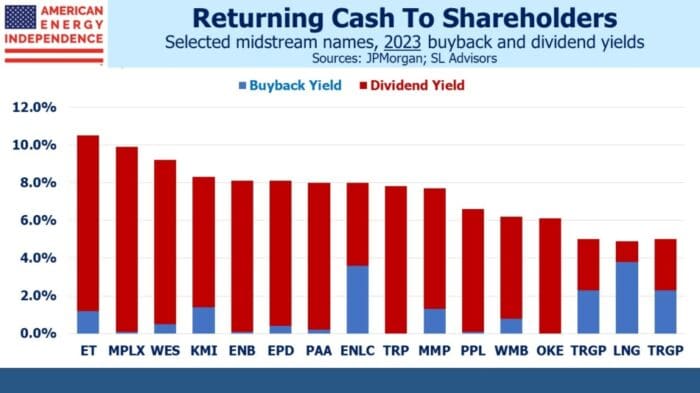



To put cash in this industry, is American energy independence index.your best suggestion?